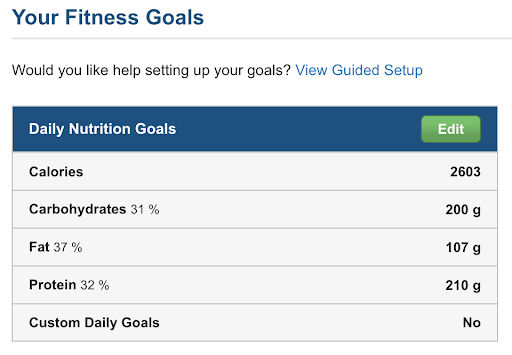
“Macro” is short for macronutrient and are the nutritive components of food that your body needs. Macros are broken into three categories: protein, carbohydrates, and fats. Your body needs these three components the most for optimal energy and body performance. Tracking macros can help you plan smart, healthy food choices and stay on top of your fitness goals.

Three Components to Your Macros
Let’s start with our three components: protein, carbs, and fat. Protein helps you build muscle, fend off infections, and grow and repair injuries. When your fitness goals include building muscle, you’ll want to up your protein intake to nourish new muscle growth. As a functional trainer, I like to emphasize the importance of recovery from injuries as well as post-workout recovery which can be aided by a substantial protein intake. You can get protein from meat like pork and fish, but you can also get protein from collagen (powders and bone broth) and protein powders.
Next up, carbs! I know sometimes we think carbs lead to weight gain, but carbs are an essential piece of your diet that gives you energy! Look to implement “complex” carbohydrates into your diet as these give you the most energy and promote your digestive health. If you’re trying to lose weight, go for a non-starchy vegetable like bell peppers, broccoli, or green beans to name a few. Potatoes, rice and quinoa are starchy carbohydrates and should be limited to 1/2 cup per meal if you’re trying to lose weight. Additionally, your carb intake will depend on your daily activity level. If it’s higher, you should be eating more healthy carbs like crunchy veggies and fruit to give your body the fuel it needs!
Don’t let the name discourage you. Fats, especially good fats, are imperative to your vitamin intake. You need fat to store fat soluble vitamins like vitamin A, D, E, and K! Dietary fat protects your organs, supports cell growth, and insulates your body during cold winters. Good sources of healthy fats are: coconut oil, olive oil, avocado oil, avocados, olives, unsweetened almond milk, almond butter, nuts, chia seeds and flaxseed.
How to Calculate Your Macros
Calculating your macros involves a little bit of easy math.
Step one is determining how many calories you eat on average (or that you should be consuming to hit your health goals). For this example, we’ll use 2,000 calories per day.
Step two is to take your daily caloric intake and multiply it by each percentage of your macros. I typically recommend that 40% of your diet is protein, 40% carbohydrates, and 20% fats.
- Carbs 2,000 x .4 (40% carbs) equals 800 calories of carbs per day.
- Protein 2,000 x .4 (40% Protein) equals 800 calories of Protein per day.
- Fat 2,000 x .2 (20% fat) equals 400 calories of fat per day.
How To: Tracking Macros
So, you just calculated your macros, now what? I suggest downloading an app, like MyFitness Pal, to make tracking macros a breeze! You’ll be able to preset your goals for protein, carbohydrates, and fats and see your progress. Apps like MyFitness Pal have features to manually input your meals or you can even scan barcodes which will automatically populate the nutritional facts for you!

Counting macros helps you understand that not all calories are equal. It’s not a “one size fits all” solution which is why it’s important to calculate macros specific to your nutritional goals. As long as you keep your diet within your macros, it’s ok to indulge in some sweets and still see results.
I hope this article gives you a macro view on nutrition to help you reach all of your nutritional goals. Nutrition is such a big part of hitting your health and wellness goals and I’m happy to offer nutrition guidance to all my personal training clients, contact me to schedule your consultation.
+ show Comments
- Hide Comments
add a comment